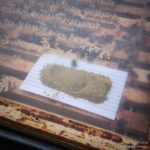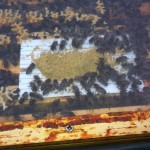Protein boost
It’s about eight weeks now until the autumn sown oil seed rape (OSR) is in full flower (late April). At the moment it’s about 4″ tall and looking rather sorry for itself in the waterlogged heavy clay soil. However, as the day length increases and the temperatures rise it will soon grow. To properly exploit the abundant OSR nectar and pollen a colony needs to be strong. That means that the workers laid in the next month or so are critical – some will be foragers during the main flow, others will be responsible for raising these workers.
Maximum daytime temperatures here are still 6-8oC … just about warm enough for flights during the middle of the day. However, not warm enough to forage for long or to travel far to collect pollen. The colonies are no longer clustered and a peek through the perspex crown board shows they are pretty active and expanding in numbers. To give them a bit of a protein boost to raise the all-important brood over the next few weeks I’ve today given them some pollen. Although it’s usually recommended to prepare pollen patties bees will also directly use dried pollen, and this is much easier to prepare and administer.
I’ve prised up the corner of the crown board on my colonies, scraped away a bit of the brace comb on the top bars to provide a flat surface and laid a small piece of card on top containing no more than a tablespoon full of dried pollen. I’ll top this up as needed during March. I think it’s important not to give them too much … firstly, there won’t initially be the need for it and, secondly the damp atmosphere in the colony means it might go mouldy before it’s used. It’s a 10 second job to give them a top-up – the crown board doesn’t even need to be removed, just lifted slightly along one edge.
The fields full of bright yellow flowering OSR feel a lifetime away on a squally, cold, early March morning. However, a bit of preparation now means the colonies should be in great condition to exploit the heavy flow and for queen rearing.



Join the discussion ...